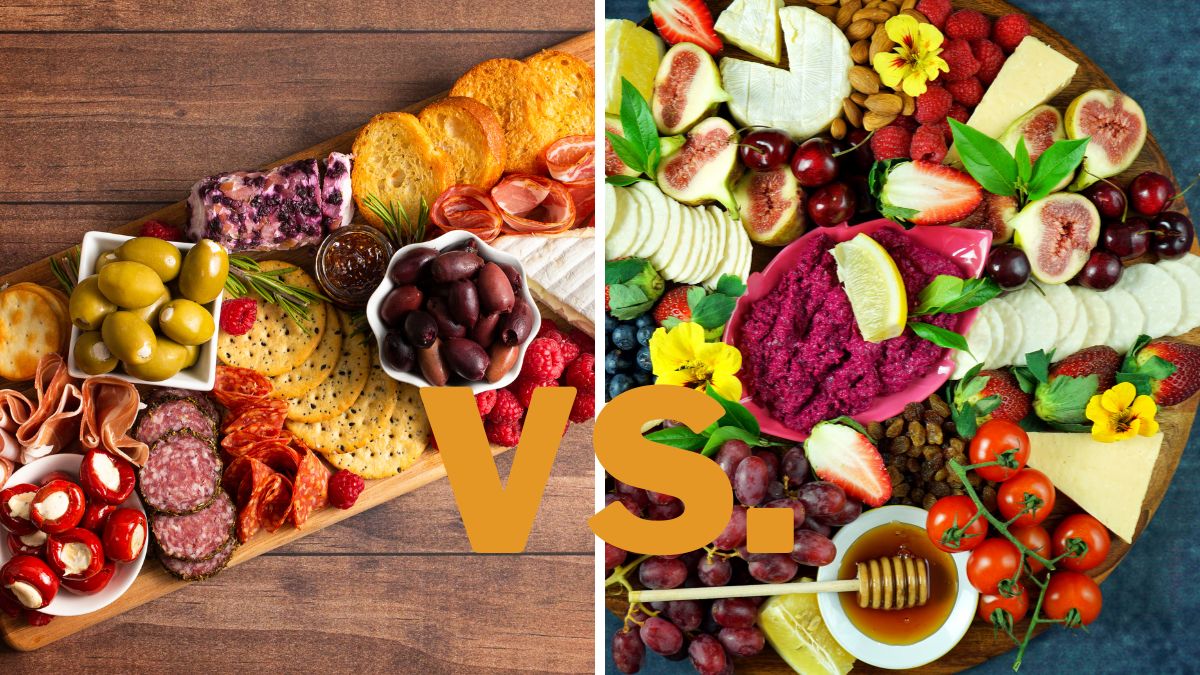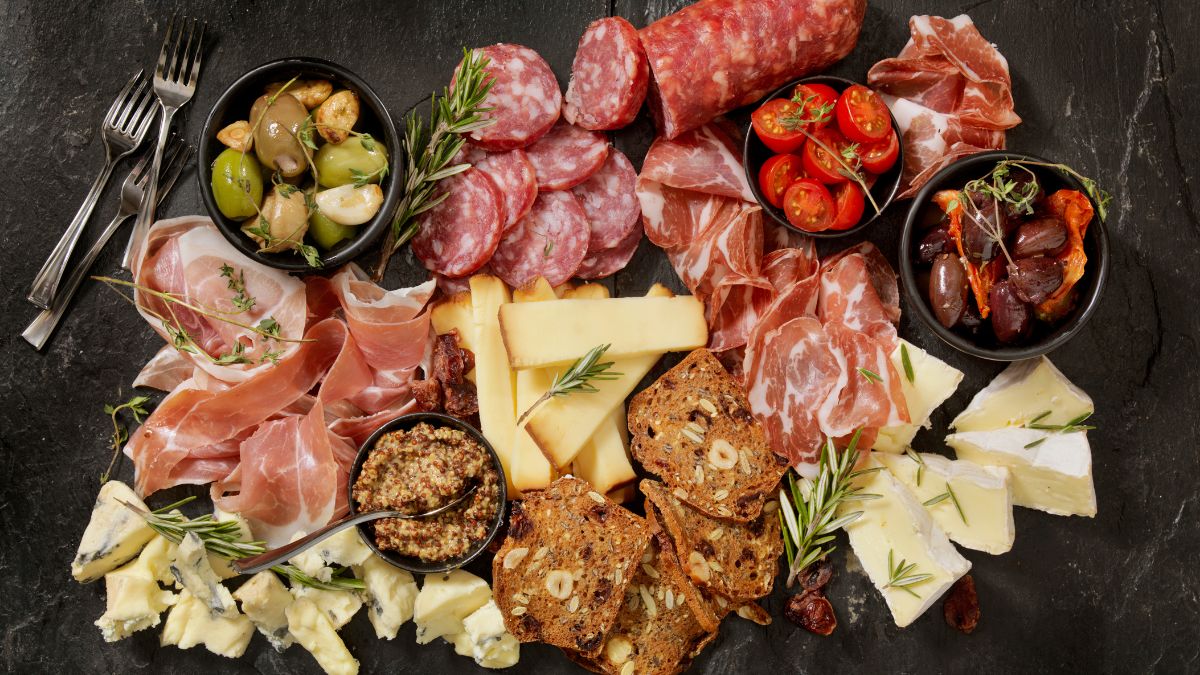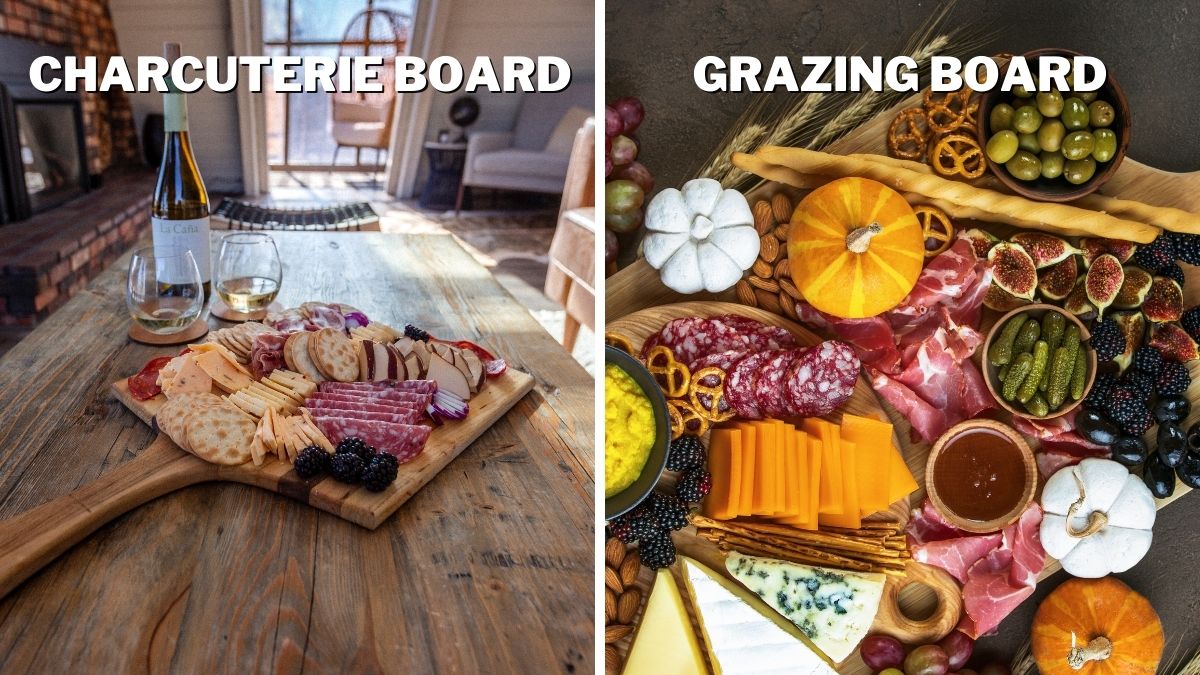Charcuterie vs. Grazing Board: Differences & Which Is Better

A few years back, I decided to gather some friends at my place with an idea of a relaxing evening spiced up with a classy snack board and wine. I sent out the invite texts and dragged my sister to the store to help me make a selection of meats, cheeses, and other goodies I would serve. While I was throwing random items in a shopping cart and talking about making a grazing board, my sister asked me: “Wait, don’t you mean a charcuterie board?” So, what’s the difference between charcuterie and grazing board?
While charcuterie boards are more popular than grazing boards, they are smaller and offer a narrower range of food items. Also, you can usually find charcuterie at formal events, while grazing boards are the stars of friend and family gatherings. Grazing boards are also usually more colorful.
Before this, it never occurred to me that these two were different. All I knew at that point was that both the charcuterie and grazing board were platforms to display various types of cheese, cured meat, olives, almonds, condiments, and other fancy ingredients. However, there are several differences between these two boards, and I will help you learn all about them in the following text.
How to Differentiate Charcuterie from Grazing Board?
There are several aspects that separate charcuterie from a grazing board. One of the most obvious is the size – charcuterie is usually smaller than graying board. They also contain different ingredients and are used for different occasions.
Appearance and Popular Ingredients
A charcuterie board is a smaller wooden platform with food items that you can categorize by the following: meat, cheeses, pickles, crunches, and condiments. Meats usually include prosciutto, salami, ham, mortadella, and even summer sausage if you are on the budget. When it comes to cheeses, it can incorporate a combination of hard and creamy cheeses such as gouda, cheddar, brie, manchego, mozzarella, ricotta, or any other cheese.
Pickles on the board are either cornichons or pickled onions. At the same time, one of the more popular condiments is spicy honey. The board should contain some crackers, almonds, or other crunchy items as well. Still, meats are the main focus of charcuterie, as you can see in the picture below.

On the other hand, a grazing board usually comes in larger sizes and includes a variety of items. Aside from meats and cheeses, fruits like grapes, figs, melons, and various berries are popular choices as well. Besides these, grazing boards should come with something crunchy, such as bruschetta, crackers, almonds, or pistachios.
Sweet, spicy, and savory condiments are welcomed on both of these boards.
Regarding appearance, charcuterie tends to have a more streamlined presentation. Since processed meats are the dominant items on the board, they are organized in stacks or fanned-out slices.
Grazing boards are usually a bit more artsy. Since they include a variety of colorful foods and are large, there is more space to express your creativity. To make some of the items stand out, you can separate them into smaller bowls or plates, making the board better structured, but you can also arrange everything on one platter — here’s how you can do this.
Occasions
Charcuterie is perfect for more formal gatherings such as birthdays, cocktail parties, brunches, and baby or bridal showers. Picnics and outdoor events are also great occasions to serve this elegant meat board.
This display is praised because of its sophistication and elegance. The artful arrangement of cured meats, cheeses, and accompaniments on a charcuterie board creates a visually appealing and aesthetically pleasing food platform.
Besides that, it contains a variety of flavors that pair well with wines and other beverages. It is highly versatile, so you can always combine the items to match the occasion.
In contrast, grazing boards are ideal for casual gatherings, picnics, and brunches. In addition to fruits, vegetables, cheese, and dips, they offer a wide variety of finger foods. A charcuterie board adds a touch of class to a formal event, but a grazing board adds a touch of comfort and visual appeal to a relaxed setting.
Variations

Charcuterie and grazing boards both offer a visually appealing way to enjoy various flavors and textures. You can combine food items on these highly-versatile boards any way you like, but the recipe comes.
Charcuterie variations revolve around processed meats such as salami, prosciutto, chorizo, and other delicacies like bresaola or saucisson sec. This platter can also have vegetarian or vegan alternatives, for instance, with marinated tofu.
I love grazing boards because they allow you to get as creative as you like, combining not only cured meats and cheeses, but also spreads, dips, nuts, fresh fruits, vegetables, and crackers.
Most of the items on the board are suitable to mix and match, so try pairing salty cured prosciutto with sweet fruits like figs, grapes, or melon, and a drizzle of honey. Or, consider spreading creamy cheese on crackers and a small amount of fruit jam. I prefer a combination with orange sauce, but fig jam can also be a lovely addition.
Both boards provide you with limitless customization, allowing you and your guests to create unique tastes and expand your flavor palette.
Popularity
Both charcuterie and grazing boards are quite popular, but for different reasons. Charcuterie boards, focused on cured meats, are favored because of their rich flavor and elegant presentation. They are especially common at upscale events, wine tastings, and gourmet dining.
Charcuterie encourages socialization and interaction among your guests. They often experiment with flavors and enjoy displaying food items together, creating a convivial atmosphere. Guests can engage in conversations about the different meats and cheeses, and exchange recommendations.
Grazing boards are a trendy choice for casual and relaxed settings. They are known for the abundant and visually appealing displays, as well as the assortment of flavors that your guests can combine as they please.
Although I prefer grazing boards because of their abundance and versatility, but also because of the casual and easy-going undertones. Unlike sit-down meals, where guests are confined to their seats, I have found that these boards create a more dynamic atmosphere by allowing them to move around and interact freely.
The popularity of charcuterie boards and grazing boards depends on the occasion and personal tastes. With both options, you can enjoy a variety of delectable bites and stimulate your senses. Still, nowadays, charcuterie boards display both elegance and abundance, and this is why they may seem more popular than grazing boards.
Which Is Better?
Individual preferences and the context of the gathering determine whether a charcuterie board or a grazing board is appropriate. Although both options offer a wide variety of flavors and textures, their primary focus differs.
Charcuterie boards are a perfect choice for meat lovers, as they provide a wide range of delicacies. They are an ideal choice for those who enjoy rich and savory notes of processed meats. Paired with cheeses, olives, pickles, and bread or crackers, they deliver a sophisticated and refined culinary experience. Charcuterie boards shine at elegant events, cocktail parties, or wine tastings, adding an air of class and sophistication to the occasion.
Grazing boards, on the other hand, offer a broader spectrum of snacks, spanning the realms of both savory and sweet. With an array of cheeses, fresh and dried fruits, nuts, crackers, bread, dips, and even dessert options, they cater to a diverse range of taste buds and dietary preferences. Grazing boards embody a casual and inclusive ambiance, making them perfect for laid-back gatherings, family get-togethers, or any occasion that embraces a relaxed and communal atmosphere.
The verdict on which is better depends on the specific event and the preferences of your guests. If you are organizing an elegant event that calls for an elevated and meat-centric experience, the charcuterie board will most likely be your first choice.
However, if you seek a versatile and inclusive spread that caters to various tastes and leaves you a space to combine and develop a new taste palette, the grazing board could be a star of the show. So, no matter if you choose one or the other, as long as it fits the purpose and general mood, you will not make a mistake. Moreover, both of these food plates will make delightful, savory, and creative additions to your social and culinary experience.
